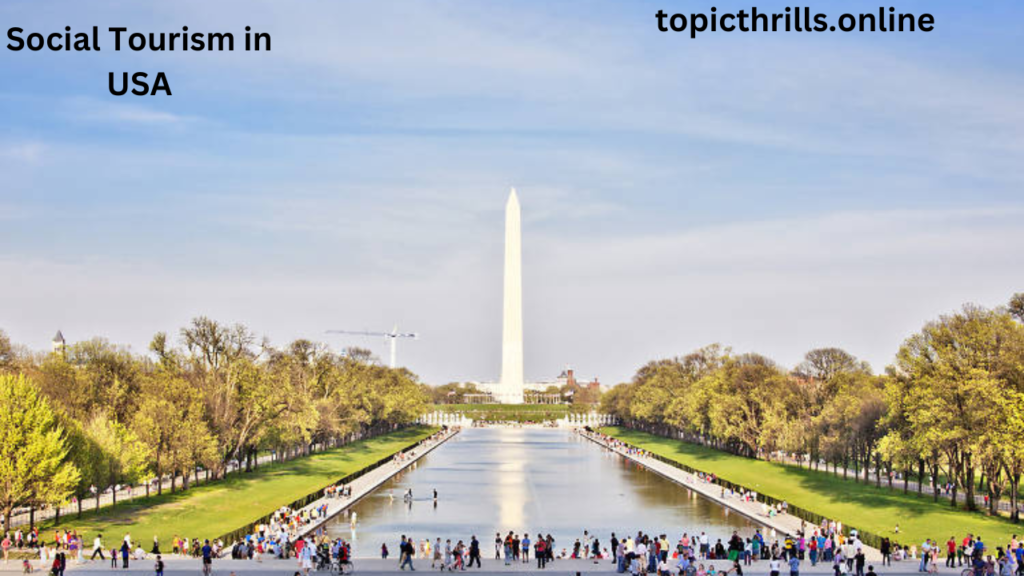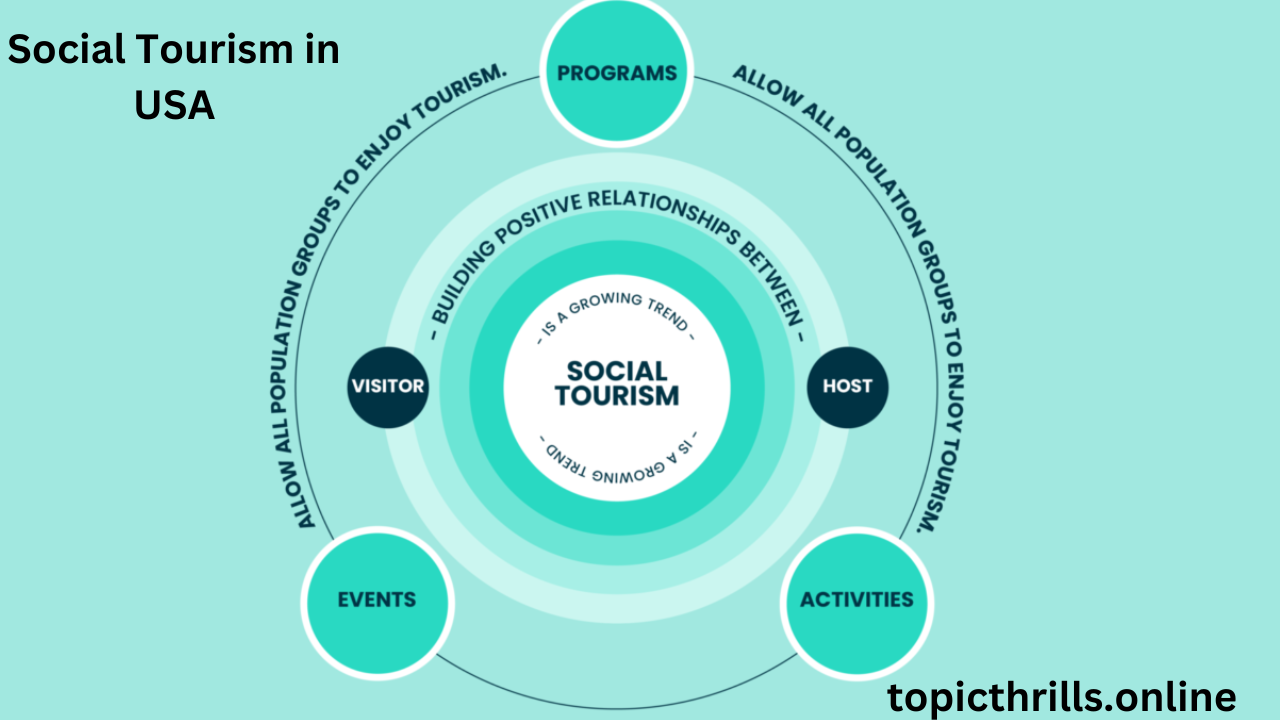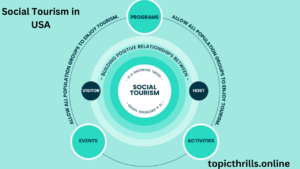Social tourism is a broad term that incorporates a variety of events and activities. Social tourism encompasses a variety of holiday kinds, including working holidays. Social tourism can be defined by the activities you engage in at the location, the sort of destination you choose, the type of accommodation you book, or a specific client group with whom a tourist organization works.

What does the term “social tourism” mean?
In a nutshell, social tourism aims to provide economic, social, and cultural advantages to both tourists and host communities.
On the other side, certain tourists may benefit from social tourism. Countless government and commercial tourism organizations give travel opportunities to groups that would not otherwise be able to enjoy them, such as underprivileged families, individuals with disabilities, children, and seniors.
Furthermore, some famous social tourism destinations are beginning to invest in more accessible infrastructure, which improves the whole trip experience. There are wheelchair-accessible beaches in Cyprus, braille-etched railings at Castel Sant ‘Elmo in Naples, and “touchable paintings” in museums all around the world.
Given the variety of forms that social tourism can take, it’s not surprising that it goes by many different names, including sustainable tourism, accessible tourism, tourism for everyone, enlightening tourism, and responsible tourism.
How is it typically financed?
Depending on the sort of social tourism, there are different ways to fund it. If you want to contribute to the destination you’re visiting, you’ll almost always have to pay for any activities or events you attend yourself. You might join a philanthropic group that covers expenses for specific activities, such as building homes for locals, which may include material costs.

However, you’d still be responsible for all other travel-related expenses, such as lodging, transportation, food, and so on. Social tourism events and activities for children, low-income families, individuals with disabilities, and others are typically entirely funded by local and federal governments, employers, and non-profit groups.
What are the goals of social tourism?
The major objectives of social tourism are:
Supporting local communities and leaving a good impact on the communities in your holiday places;
Discovering new destinations – exploring places off the beaten path and going to less frequented countries;
Learn about new civilizations by getting to know the locals, their languages, cultures, traditions, and history.
Providing economic benefits to host countries – purchasing locally, investing in arts and crafts from local artists, and strengthening the local economy.
Making travel accessible to everyone – allowing everyone to enjoy the benefits of travel, regardless of socioeconomic status, age, health, or other factors.
How can we help social tourism?
Support charities and non-profits: Many social tourism nonprofits rely on individual contributions to provide immersion programs and activities that benefit both visitors and host countries. Donate to relevant organizations that support local communities in your favorite travel destinations or those who provide travel chances to underprivileged groups in your area.
Volunteer – Join volunteer groups that link you with locals. Avoid popular destinations and instead visit lesser-known ones.
Talk to your local government representatives – Because many social travel activities are government-funded, you can consult with local officials to determine the best ways to encourage social tourism.
Examples of social tourism initiatives:
Lough Ree Access for All provides wheelchair users with the opportunity to experience life on the water, which many of us take for granted, through accessible boat ride. This exemplifies how social tourism may be considered accessible tourism.

Città Solare is an Italian cooperative that promotes social integration for locals and immigrants in environmental services, industrial manufacturing, and hospitality. Their Casa di Colori accommodation offers reasonably priced rooms for short- or medium-term stays for those traveling for employment, tourism, study, medical treatment, cultural or sporting events, as well as creating jobs and providing temporary shelter for marginalized people.
4 Ways of getting benefits from social tourism:
Raising Awareness of Important Social Issues:
As previously said, these homeless street tours increase awareness about the lives of a minority that is marginalized by society. This can be critical for deconstructing stigmas and cognitive patterns, as well as motivating tourists and the general public to participate and contribute in a proactive manner. Unseen excursions provide excursions and experiences throughout the United Kingdom that are curated and conducted by tour guides who have been homeless themselves.
In Copenhagen, Street Voices offers comparable services to tourists of Denmark’s capital, and in Prague with Pragulic. Other capitals, such as Berlin, have highlighted the refugee situation by sharing stories from those who have had to escape their homes. Refugee Voices excursions offer walking excursions led by Eritrean and Syrian guides. These social initiatives demonstrate how tourism may be more inclusive of marginalized communities, boost their sense of belonging, and allow them to share their authentic, honest, real-life stories.
2. Combats seasonality and contributes to sustainable tourism:
It has been suggested that visitor-related social tourism can address the issue of seasonality by providing off-season budget holidays to groups such as the retired community and low-income families, resulting in more sustainable locations. This allows the sector to survive for a longer period of time and creates additional job opportunities. Senator, for example, extends the season and promotes off-season travel.
3.Health and Well-Being Improvements:
Other advantages include improved health and more self-efficacy. According to research, participating in social tourism has resulted in favorable changes in visitors’ physical, mental, cardiac, and vascular health, as well as an increase in their quality of life, well-being, and knowledge. In a study of low-income families, researchers determined that social tourism programs strengthened family ties by allowing them to spend more time together and form stronger bonds, which had a favorable impact on behavioral change. Traveling and tourism broadens travelers’ thoughts, increasing serotonin and curiosity levels, as well as their urge to explore.

4. Promotes a More Inclusive Society:
Many experts have identified social tourism as a form of tourism that benefits the local community. This article contains numerous instances of how social policies and efforts around the world have purposefully constructed programmed that provide opportunities to diverse groups within our society, with the goal of making tourism more inclusive and accessible to all.
Objectives of social tourism:
Tourism may significantly improve the health of the elderly and persons with disabilities, as well as combat hypokinesia, which can have negative effects on both physical and mental health.
Movement-related constraints greatly reduce living opportunities, resulting in sadness, despair, stress,
and a lack of self-confidence.
Tourism, psychosomatic therapy, and preventive help maintain physical training and health. Tourism fosters a communicative environment that allows individuals with disabilities to communicate with others, form social connections, and participate in various activities. Tourism reduces feelings of inferiority and promotes social inclusion for vulnerable groups such as the elderly and disabled.
Social tourism refers to any sort of tourism that is funded by monies set aside for social purposes. Social and economic tourism attempts to provide leisure opportunities for low-income individuals, including youth, schoolchildren, people with disabilities, elderly, and large families.
Orphans, orphanage children, and people with disabilities. Subsidies for this form of tourism might be provided by various government, commercial, and nonprofit groups.
Social policy prioritizes human well-being over economic progress and wealth accumulation.
The government regulates the development of social tourism:
A long-term social tourism program is crucial for its development.
Funds for social tours are frequently distributed directly to the recipients. Several countries have addressed the issue of disabled individuals’ access to travel. Many European cities have customized elevators and tourist itineraries allow for wheelchair travel.
Subsidies for special equipment, such as ramps and buses for social needs, are necessary for small travel organizations that provide social tourism services.
FAQS:
What are some examples of social tourism in USA?
Retreats, wellness seminars, and mindfulness experiences are included into social tourism programs to allow participants to rest, recharge, and improve personally. There is a rising recognition of the importance of inclusive tourism experiences that appeal to people of all backgrounds, abilities, and needs.
What is social tourism?
Social tourism is the use of travel and tourism to provide economic opportunities for people who are economically or otherwise disadvantaged. According to this understanding, social tourism activities are primarily intended to provide economic benefits to the host community.
What is the US tourism strategy?
The National Travel and Tourism Strategy directs federal efforts in collaboration with the private sector to improve the worldwide competitiveness of U.S. travel and tourism and to create a more fair, resilient, and sustainable industry for the future.
Where in the US has the most tourism?
Over 40% of travelers interested in visiting the United States include New York on their bucket list. Or more particularly, New York City. The largest metropolis in the United States boasts notable sites like the Statue of Liberty, the Empire State Building, and Times Square.
What are the 3 social impacts of tourism?
Tourism has positive social consequences such as learning about foreign cultures, expanding tolerance and inclusion through LGBTQ+ travel, boosting amenities (e.g., parks, recreation facilities), investing in arts and culture, celebrating Indigenous peoples, and instilling communal pride.
Conclusion:
The social tourism project should provide recreation opportunities for the elderly, refugees, children, low-income families, and individuals with disabilities. Social tourism services should be available in resorts, rural areas, and mountains. Exchanges including social tourism can help combat Seasonality and the growth of regional and local economies.
Younger visitors seek comprehensive information about a nation, including not only its natural beauty but also its people and lifestyles. Visitors aim to explore the country, share their culture, and contribute to the economic development of the village and region through tourism services. Social tourism enables all of this. These are the aspects of social tourism in the US. In case of any difficulty contact us through our link on website. I hope it will beneficial for you. Thanks.





